Exercising an Otterhound: Everything You Need to Know

The Otterhound is a breed wrapped in history, originally bred for hunting otters in England. Boasting a unique rough coat and a distinctive nose, this breed is both energetic and playful. If you're lucky enough to have an Otterhound as part of your family or are considering adopting one, it's vital to understand their exercise needs. Dive into this comprehensive guide on everything you need to know about exercising an Otterhound to ensure a happy, healthy, and well-adjusted companion.
1. Recognizing the Otterhound's Energy Levels
The Otterhound, with its strong hunting lineage, possesses a high level of energy and stamina. Regular exercise is essential for both their physical and mental well-being.
2. Key Exercise Techniques for Otterhounds
- Walking: A brisk 30-45 minute walk twice a day can help keep their energy levels in check.
- Running: Given a safe environment, let your Otterhound run freely. Consider off-leash dog parks or fenced-in yards.
- Swimming: With their webbed feet, Otterhounds are natural swimmers. This low-impact exercise is excellent for their joints.
3. Mental Stimulation is Key
Otterhounds, being intelligent dogs, need mental workouts as much as physical ones.
- Puzzle toys: Keep them engaged when indoors.
- Training sessions: Teach them new tricks or commands. It's never too late to teach an Otterhound!
- Interactive games: Hide-and-seek or fetch can keep their brains and bodies active.
4. Exercising Puppies vs. Adult Otterhounds
Puppies have developing joints, so exercise should be moderate and not forceful.
- Puppies: Shorter, multiple walks and play sessions daily. Avoid strenuous activities until they're older.
- Adults: Longer, more intense exercise sessions. Incorporate activities like hiking or agility training.
5. Safety First
- Overexertion: Be mindful of your Otterhound's limits. If they show signs of fatigue or disinterest, it's time for a break.
- Weather conditions: Otterhounds can overheat. On hot days, exercise during cooler times like early morning or late evening.
- Hydration: Always carry fresh water during exercise sessions.
6. Joining Otterhound Groups
Joining groups or clubs can provide both you and your Otterhound with a sense of community and additional resources.
- Group walks: Meeting with other Otterhounds and their owners can make exercise sessions more enjoyable.
- Training classes: Useful for socialization and learning advanced commands.
Conclusion
The Otterhound is an energetic and enthusiastic breed that requires consistent and varied exercise. By understanding and meeting their needs, you're ensuring a healthier and happier life for your furry friend. Whether it's a stroll in the park, a splash in the pond, or a game of fetch, keeping your Otterhound active is key to their well-being. Remember, a well-exercised Otterhound is a content and delightful companion!